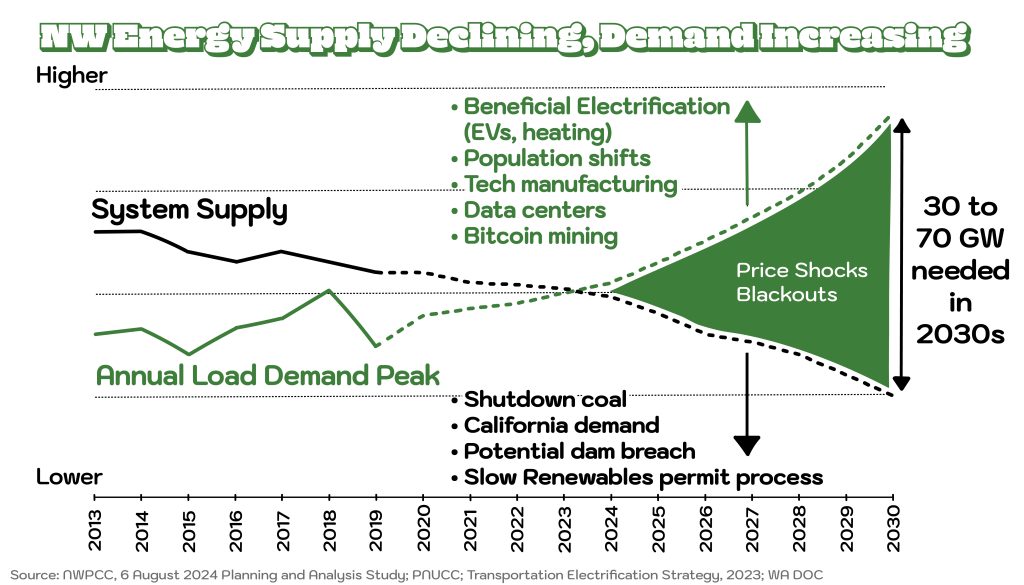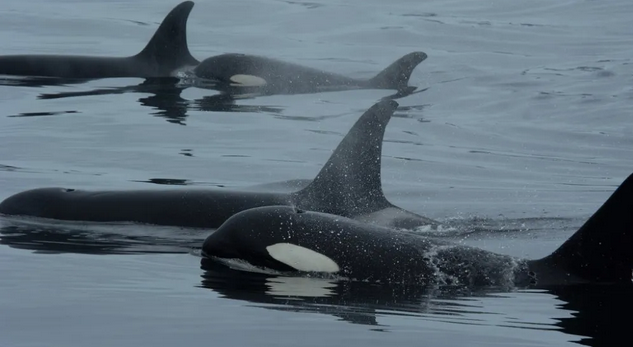||| FROM KRISTA BOUCHEY for ORCAS POWER & LIGHT |||
OPALCO has been providing reliable power to the islands since 1937. Electricity is an essential and critical component to the modern-day lifestyles powering our hospitals, grocery stores, heating systems, and fire departments. Constant electricity does not come without some tradeoffs. As a cooperative, OPALCO looks to the members to support the grid infrastructure that serves our daily lives. As a community we will need to continue to build and maintain our power system and now more than ever we need to be looking at reliable, renewable carbon free solutions.
The energy industry is at a critical point as the region and the world are feeling the effects of climate change. Washington State is a leader in transitioning away from fossil fuels with strong carbon reduction legislation and funds towards renewable energy.
Electricity demands are spiking as many transition away from gas powered vehicles and fossil fuel heating sources. Additionally, there is an increase in AI technologies and data centers that are high energy users. The regional energy supply is at capacity, and there is a strong need to build more sources of renewable power.
The OPALCO team spends endless hours looking at the future electricity needs for our community. Bonneville Power Administration (BPA), which supplies 96% of OPALCO’s power, will not be building more power generation, and energy deficits are expected to occur within the next two years and continue well into the future. This means that OPALCO will need to start building local power generation or buy power from the market at dramatically higher prices. This demand versus supply shortfall could result in regional black outs during peak weather events.
The Northwest Power & Conservation Council estimates a minimum of 30 GW of new power will be needed by 2030. Providing this much new generation will be extremely challenging. With siting and permitting setbacks, the Northwest has only been able to build out 1 GW over the last 8-year period. The amount of new power solutions to keep our grid reliable is staggering.
Renewable energy projects take years to plan, permit, and construct. The longer we delay building these projects the longer it will take for supply to catch up with demand and the more likely the energy needs will be filled with carbon-based fuel sources.
Regional electric supply
To reverse the global climate catastrophe, the US must cut emissions by 50% by 2030. That is a lofty and challenging goal that is highlighting the need to bring on renewable energy projects in San Juan County and throughout the region.
Demand is increasing as the Northwest population grows and turns to electricity for transportation and heating. Data centers have proliferated throughout the Northwest due to our cheap and abundant hydropower and are contributing to the increased demand. Washington State legislators are also increasing demand for renewable electricity by encouraging us to electrify residential heating, EV transportation and requiring energy users to pay climate penalties for using carbon-based energy sources.

Supply throughout the Northwest is lessening as coal power plants are shut down but replacement energy projects are held up or cancelled due to public and local permitting pushback. The regional hydro system is now at capacity with no plans to bring on more hydro power.
With the current trajectories, rolling blackouts and market price shocks will increase until supply can meet demand. OPALCO can invest in off-island generation projects, however, this doesn’t benefit the local grid. Only local generation will benefit the islands with reliable power if/when the power goes off on the mainland.
How can we prepare as a community?
San Juan County gets most of its power from the mainland via submarine cables. During the January 2024 cold snap, OPALCO’s electric bill from our mainland power supply had a $310,000 demand charge. Due to price shocks like these and the heightened likelihood of mainland blackouts, it’s increasingly necessary for our community to start exploring local, renewable energy projects.
OPALCO has long been encouraging conservation efforts with rebates for energy efficiency projects. The Switch It Up program encourages the wise use of electricity by offering on-bill financing for conservation and renewable energy projects. Electric vehicles are 5 times more efficient than gas cars and heat pumps are 3 times more efficient than other heaters. Through this program, close to $20M has been invested in our community in energy savings projects.
A clean energy future, which is critical for protecting the health and resilience of the Salish Sea and our pristine maritime environment, is going to require a broad mix of renewable energy sources. Tidal energy technologies show great promise in adding to our portfolio of energy needs. OPALCO is currently in the process of studying the feasibility of a 2MW tidal generator in Rosario Strait with funding from the Department of Energy.
What about rooftop solar?
There is a misconception out there that if you put solar on all rooftops and parking lots, the problem is solved. Unfortunately, rooftop solar is not the “silver bullet”.
Rooftop solar has been growing throughout San Juan County. Installations have increased since 2022 when OPALCO made their on-bill financing program available for solar and battery projects. About $7.5M in local rooftop solar and battery storage projects have been financed through OPALCO’s program.
OPALCO strongly encourages those who have rooftops that are viable to install solar, but this alone isnot going to meet the projected load growth for San Juan County. Rooftop solar can only supply about 5% of our projected local energy needs (assuming we can max this out). We need to explore utility scale renewable energy projects to meet our future energy needs.
Utility Scale Microgrids
The proposed Bailer Hill microgrid could more than double the county’s rooftop solar generation. This project is an agri-solar system that will partner with local farmers to graze sheep in the shade of the solar array. Pairing solar with battery storage ensures that we can access the energy when the sun isn’t shining, making it more of a reliable source of power for the county.
This and future microgrids can only happen if there is support from the public. On the mainland, over 70% of utility renewable energy projects are canceled due to local permitting and public opposition. Each year we delay this Bailer Hill microgrid is equivalent to burning 230,000 gallons of gasoline or emitting 4.5 million pounds of CO2. We can’t afford to wait for these projects.
Our community and planet will greatly benefit by investing now in local, renewable generation projects. It is time for us to step up, invest in solutions, and begin to address these critical issues we face. OPALCO needs the support of co-op members to get these projects up and running.
OPALCO has sources for the data shared and more detailed information about this article on the OPALCO website. Email communications@opalco.com if you have questions or want to go deeper. Part two of this three-part series, will dive into why OPALCO chose Bailer Hill as the site for a future microgrid.
Orcas Power & Light Cooperative (OPALCO) is our member-owned cooperative electric utility, serving more than 11,400 members on 20 islands in San Juan County. OPALCO provides electricity that is 97% greenhouse-gas free and is generated predominantly by hydroelectric plants. OPALCO was founded in 1937.
**If you are reading theOrcasonian for free, thank your fellow islanders. If you would like to support theOrcasonian CLICK HERE to set your modestly-priced, voluntary subscription. Otherwise, no worries; we’re happy to share with you.**









Thank you, Krista, for putting the situation in perspective. The issues of dams, salmon, orcas, electric boats and ferries, and air quality are all intertwined with the issues you mention; this is not a problem for one-issue people.
I’m looking forward to apartment and condominium microgrids with the benefits prorated on the same basis rents/HOA dues are calculated. Looking at the future, today’s installation cost could be attractive micro-community/developer investments. Though solar by itself is insufficient, everything helps, and in individual cases, it helps a lot.
Krista, Thank you so much for sharing this information. I live in an area that is not conducive to solar panels and am interested in battery bank systems. Does OPALCO have any programs involving homeowners banking power in batteries that can be fed back to the grid during peak demand times?
Thank you for this enlightening overview, Krista. OPALCO members need to know what’s at stake and may be facing us in the near future — like possible blackouts during times of extreme demand — as we came close to a year ago during the January 2024 cold snap. And I’m glad you twice mentioned the impact of data centers on the demand side, which was the subject of my Seattle Times essay:
https://www.seattletimes.com/opinion/the-ai-power-struggle-data-centers-are-in-a-desperate-search-for-energy/
These data centers are springing up rapidly, due in large part to what has been called “the AI gold rush” going on in response to generative AI programs like ChatbotGPT. I cannot imagine how public utilities can ever keep up with their bloated electricity demands, given the siting and construction problems you outline. This is a place where our legislators and governor need to step in and regulate this industry before it begins to have serious impact on our power supplies. I’ve mentioned the problem to Alex and Debra, but so far they don’t seem to be taking it seriously. Maybe if more people join the chorus, they will wake up and take action!
Sniff, sniff… in view of the larger picture, and considering the immediacy of the situation, with the trend related to our power use still leaning towards more and not less, something seems to be lacking with a long-term approach consisting of planning, procuring, permitting, and building an “everything on deck” alternative energy infrastructure that does not include a massive conservation / degrowth component.
I mean which seems more feasible, (or should I say “impossible”)? All of the “we must” items mentioned in the article above… or embark upon a strategy centered around conservation and degrowth?
As one who practices extreme conservation (and always have), thus being a minor consumer, pretty much a one lamp, one small electric heater next to my computer kinda guy who drives less than 5 miles a day… it ruffles me to think that Washington State legislators are going to require energy users (like myself) to pay climate penalties for using carbon-based energy sources in view of all the wasteful major consumers around me. I can hardly afford to pay my electric bill now (with the taxes and fees being more than my actual usage). I hope when the time comes for this incentive to be enacted that this climate penalty will reflect that, and that the major consumers will stop getting tax-funded subsidies, tax breaks, and lower prices on their energy usage.
And let’s face it… as other places around the nation continue to burn, blow, drought, flood, and freeze… the NW is starting to look pretty good to them.
Shouldn’t the word “needed” be added to this statement (5th paragraph)– “The amount of new power solutions to keep our grid reliable is staggering.”
With this article, the people at OPALCO reveal that they do not understand basic climate science.
I will focus on one sentence primarily: “To reverse the global climate catastrophe, the US must cut emissions by 50% by 2030.”
While cutting emissions will certainly slow climate change, we cannot reverse climate change until we entirely stop doing two things:
1) extracting and burning fossil fuels, and
2) destroying the land.
The second might be surprising to you, but “land-use change” — e.g. cutting down forests, damming rivers, paving over wetlands, removing topsoil, etc. — is responsible for 20-25% of global climate change.
All human activity that contributes to CO2 equivalent parts per million (written CO2e, meaning CO2, methane, and other greenhouse gases) over and above the Earth’s natural carbon cycle will increase global warming. Emitting less CO2 and other greenhouse gases will thus slow global warming, but will not “reverse” it.
This includes, say, removing trees for solar panels, burning diesel to mine lithium for EV car batteries, destroying land to mine copper and silver and nickel and iron ore and molybdenum and quartz for batteries and solar panels and wind turbines and cables for so-called “renewable” energy (actually rebuildable technologies) and EVs that OPALCO claims will somehow help “reverse” climate change. No, they won’t. Alternative forms of energy will help supply the energy we demand in Washington and here in San Juan County, but will do nothing to “reverse” climate change.
OPALCO is making co-op policy based on climate change, but obviously does not fully understand climate science.
So, a little climate science for those who care:
By burning fossil fuels and destroying land (and wetlands and rivers), we (humanity) have doubled CO2e over the pre-industrial baseline. CO2e in 2023 was measured at 534ppm.
Adding more greenhouse gases to the atmosphere, whether through burning fossil fuels or land-use change, is like turning up the oven; it takes a while for the temperature in the oven to catch up. Likewise, when we add CO2e to the atmosphere, it takes a little while for the Earth’s global temperature to catch up.
The best estimate of Equilibrium Climate Sensitivity (ECS) — that is, the estimated temperature rise on a doubling of greenhouse gases in the atmosphere — is +3C. The global temperature has risen about +1.5C so far (2024 global temperature will likely be +1.59C above the baseline global temperature), so there’s another +1.5C “baked in” to the Earth’s system — a system that tries to create “equilibrium” between the greenhouse gases in the atmosphere and the temperature (which is why it’s called ECS). In other words, we can expect about another +1.5C of warming, even if we stopped burning all fossil fuels and stopped destroying the land *today*.
As long as we continue to burn any fossil fuels or destroy carbon sequestering soil and forests, climate change will continue to get worse.
There is no amount of “renewable” energy that will stop global warming, especially since “renewable” energy and EVs require destroying land to mine copper to wire our cars or our solar panels, mining bitumen to make asphalt for the roads our EVs are driven on, and mining and burning coal to make silicon for solar panels, steel for wind turbines, and concrete to maintain the dams.
All energy, whether fossil fuels or hydro or “renewable”, simply maintains our ability to live our comfortable lives. As my series on ecological overshoot (from fall 2023) showed, average Americans have an ecological footprint 10-15 times the global average, which in total is 1.75 times what Earth can handle (many people in the world still have an ecological footprint below 1, which is the only reason the global footprint is not higher).
OPALCO needs to be honest. More local electricity generation isn’t about climate change at all; it’s about maintaining our extravagant, energy-profligate lifestyles.
And we all need to be honest about our incredibly profligate lifestyles and unfair ecological footprint. Until we are honest, we will never make the changes we actually need: to use a whole lot less energy, and to protect and restore ecosystems whenever and wherever we can.
There are many ways to take climate action. Ms. Robson’s can work for some. Many may know that OPALCO is mandated to provide co-op members with as much safe, reliable energy as they need. We provide leading energy efficiency and generation programs to help reduce waste and generate locally.
Our statement that the U.S. must cut emissions by 50% by 2030 is consistent with the globally recognized pathway to limiting warming to 1.5°C, as outlined by the Intergovernmental Panel on Climate Change (IPCC). No credible scientist or policymaker claims that emissions reductions will magically undo past warming. The goal is to mitigate further damage and prevent catastrophic runaway climate change.
There are no perfect solutions. OPALCO is looking to work with our members to reduce fossil fuel usage and increase local energy resilience with a variety of solutions
To put things in perspective, the 30 gigawatts of additional peak power mentioned in Krista’s article correspond to the output of 36 Three Mile Island nuclear reactors, one of which Microsoft is hoping to resuccitate to supply power to its growing armada of data centers in Pennsylvania.
I am with Elizabeth and Michael on this issue; our only viable response is L.E.S.S. (Less Energy, Stuff & Stimulation). No doubt it will be tough going with the culture-wide delusion of perpetual growth underpinning so much collective decision making. At the individual level though, making do with L.E.S.S. can be incredibly freeing and ultimately it really is the sum of our individual actions that make up the global whole.
Krista, you write “No credible scientist or policymaker claims that emissions reductions will magically undo past warming” but by using the word “reverse” that’s exactly what you were saying. I’m glad to know that despite your use of that word in your article, you understand the science.
We are already at +1.5C (or nearly so depending on which metrics are used, e.g. average of previous 20 years, or average of previous 10 + next 10 in the models), so that goal is already dead in the water.
I completely understand that OPALCO is mandated to supply electricity to meet demand, which is why, in my most recent article for the Orcasonian, I laid out steps that we citizens can take to dramatically reduce our demand (short summary: get out of the growth management act, replace it with a degrowth management and ecosystem restoration act, and reduce, reduce, reduce).
We know that whatever electricity/energy we free up by not using it here in the county will fuel a growing global economy elsewhere (at least in the short term) — whether that’s new data centers in WA state, or something else — so it is unlikely anything we do here will change the path the world is on to +3C and likely beyond (although I’d like to imagine we could lead by example).
So the best thing to come out of a degrowth plan here in the county, aside from alleviating the need to generate a lot of new, local electricity here, would be to prepare us for a significantly different world that is ahead.
Just a few days ago, I read a paper published by a group of actuaries in the UK who are advising financial clients to prepare for “50% percent GDP destruction” at +3C (their words). A global temperature rise of +3C includes the oceans, and would equate to +10-15C over land. +3C globally is essentially inevitable at this point given current CO2e ppm and no sign the world is going to change track. If this is indeed the path we are on, it would be prudent for the people of this county to begin planning to use less energy and electricity.
Also, recall that climate change is just one of many symptoms of ecological overshoot, and adjust plans accordingly.
I am repeating myself, I know, but maybe at some point it’ll sink in?
Hi Ms. Pi
Members can use OPALCO’s on-bill financing program for battery storage projects. Find info here: https://www.opalco.com/save/the-island-way/switch-it-up/
And yet with an increase in demand for power opalco board voted to lower what they pay out to those of us pumping power back to the grid…
Such a scam
Honestly it’s all a big joke… but by all means keep buying into it….
Want to know more, buy a system, install it, watch the numbers that Opalco says you are selling back to them and as compared to what your new Tesla system says you are really selling them…. the numbers are off by a lot.
Then ask Opalco, they will tell you it’s lost in the line.
So I pay what is lost in the line now both buying and selling to Opalco….
Brilliant….
But by all means keep telling everyone the misinformation of it all….
Melissa, if you work it through, paying local generators retail rates, which are higher than OPALCO’s contracted source, means that those who do not (and many cannot) furnish power to OPALCO pay higher rates because OPALCO is reselling power it once purchased from you at retail. This is a logical reason for paying local generators only the same rate at which OPALCO purchases power from BPA and not permit local generators to add to the burden already carried by those having difficulty paying for electric power.
Though I’m all for an “all hands in deck” approach utilizing every source of non-carbon power that we can (though I’m not hot on nuclear power), as long as we are shooting for more conservation and degrowth strategies at the same time… it is worth noting, as was just pointed out to me by a friend–
“Krista said: “Our statement that the U.S. must cut emissions by 50% by 2030 is consistent with the globally recognized pathway to limiting warming to 1.5°C, as outlined by the Intergovernmental Panel on Climate Change (IPCC).”
The official global temperature for 2024 is +1.6C (Copernicus) to +1.62C (Berkeley Earth).